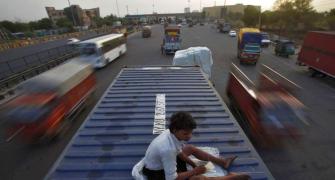New GDP math sends high-frequency indicators out of whack, notes Malini Bhupta
 India is set to exit FY15 as the second largest largest BRIC economy this year, as the GDP hits $2 trillion.
India is set to exit FY15 as the second largest largest BRIC economy this year, as the GDP hits $2 trillion.
The Central Statistical Office is estimating the Indian economy to grow by 7.5% in the fiscal year 2014-15.
With this, India would have earned itself the dubious distinction of becoming the fastest growing economy in the world alongside China.
China grew by 7.4% in calendar 2014, missing its internal target of 7.5%.
Economists and analysts are not convinced by such a feat as the math does not seem to add up.
ICICI Bank's Treasury Research says the new GDP estimates have raised some questions, prima facie, as they don’t seem to be in keeping with current activity indicators.
The CSO's new measure of economy (higher growth in the current and previous fiscals) is based on improved efficiency and productivity.
Even though nominal GDP is not showing any sharp uptick, falling inflation has helped dress up the headline numbers. If one looks at nominal GDP, then the picture is slightly different.
According to CSO, nominal GDP in FY15 is expected to grow by 11.5% against the estimated 13.4% in the Union Budget.
So even as nominal GDP is down, the real GDP is showing another picture because the government's inflation assumptions are closer to the WPI rather than the CPI.
Technically, the Indian economy is on road to recovery after hitting a trough in FY13 (5.1% GDP growth).
Since then, the economy has bounced back. Under the new GDP series, the economy expanded 7.5% in the December quarter.
Not just this, GDP growth in FY15 is expected to be 7.4%, which is higher than last year's 6.9%.
Given that China is expected to grow close to 7% in 2015 and below that by 2016, India has become the fastest growing economy in the world.
Economists and analysts are not taking these numbers seriously as the new GDP series seem to be in sharp contrast to the high frequency indicators.
Budget 2015: Complete Coverage
Growth in FY15 would have been close to eight% were it not for the weak monsoon, which dragged GDP down in the third quarter.
The steep recovery in growth seems to be despite the contraction in savings, investment and tax collections.
In a note, Dharmakirti Joshi, chief economist at Crisil Research, says: "The new GDP math sends high-frequency indicators out of whack.
Credit growth does not sync with the sharp pick-up in GDP growth now shown for this fiscal.
Credit growth is expected to be around 12-14% compared with 14.3% as of fiscal 2014-end.
Growth in service tax collections (nearly 50% of it comes from finance, real estate and professional services) slowed 10.2% in the year so far (April to December), compared to 19.2% in the same period of fiscal 2014."
In the September quarter of the current fiscal, the economy expanded by 8.2% year-on-year.
This wondrous feat has left many experts flummoxed as the pace of expansion defies logic. Most economists are sticking with the older series and projections based on it.
HSBC Global Research says the pace at which the economy has been growing in the last several quarters and the pace at which it has slowed are much higher than in the old series and will take time to assess.
Anubhuti Sahay and Samiran Chakraborty of Standard Chartered Global Research said in a note that the strong results need to be interpreted with caution, as activity indicators and sentiment surveys underline significant slack in the economy.
There are two other factors that must be kept in mind.
First, with this kind of a growth trajectory, India has isolated itself from the rest of the world, which is battling deflation.
Second, the new GDP series are showing sharply higher growth rates primarily because of a drop in inflation and under-estimation of the efficiency of capital employed.
Dhananjay Sinha of Emkay Global says the primary factor for sharp upward revisions in GDP growth has been the better capital efficiency, measured by Incremental capital-output ratio, which measures the unit of capital required to generate a unit of output.
This ratio has fallen from eight in FY13 to 5.2 last year and is estimated to have improved further to 4.8 this year.
The lower the ICOR, the more efficient is the utilisation of capital and, therefore, higher growth.
If the economy is firing from all cylinders and recovery has been underway then tax collections should also be growing in India.
India's gross tax revenue growth has fallen to 9.2% in the first nine months of FY15 from seven% in the same period last year. In FY13, gross tax revenue grew at 15%.
This economic recovery is not accompanied by corporate earnings growth.
WHAT'S WRONG WITH THE NEW GDP SERIES
1. The new GDP series accounts for much lower inflation than recorded by CPI-2010 base, says CRISIL Research. Inflation computed based upon changes in the GDP deflator (ratio of nominal to real GDP) fell to 3.8% in this fiscal from 6.3% in the last, while CRISIL estimates CPI to fall to 6.7% from 9.5%.
2. This combination of fastest growth in the world, subdued inflation and narrowing twin deficit, Indian economy appears to have isolated itself from the weak global environment, says Emkay Global
3. Extent of nominal GDP change due to new series is relatively minor. Dollar GDP unaltered between old and new GDP series, but economy set to touch $2 trillion in FY15 due to stable INR says Motilal Oswal
4. Prima facie the new GDP estimates have raised some questions as they don’t seem to be in keeping with current activity indicators. More clarity on methodology is awaited, says ICICI Bank Treasury Research
5. Motilal Oswal's note says that the CSO seems to have mixed up once again, as expenditure side components not adding up for the new series (constant prices)
6. The deflator used in the new series is much closer to the WPI measure and not the CPI which is what the central bank is now tracking
Image: A boy eats roti at a slum in Mumbai. Photograph: Arko Datta/Reuters










